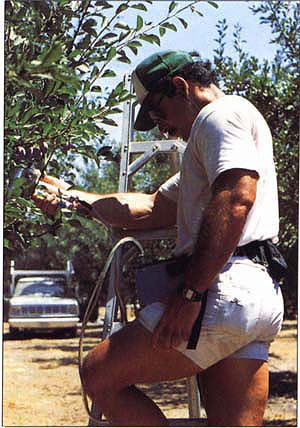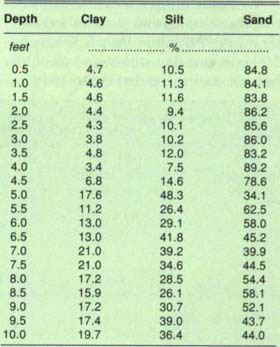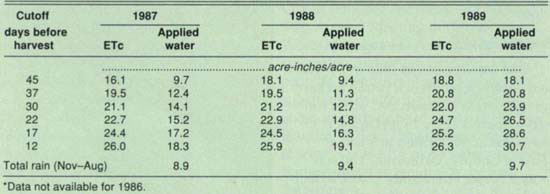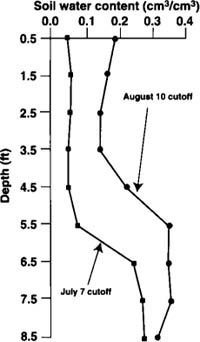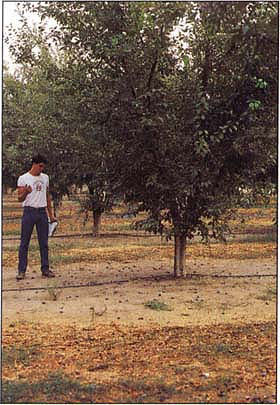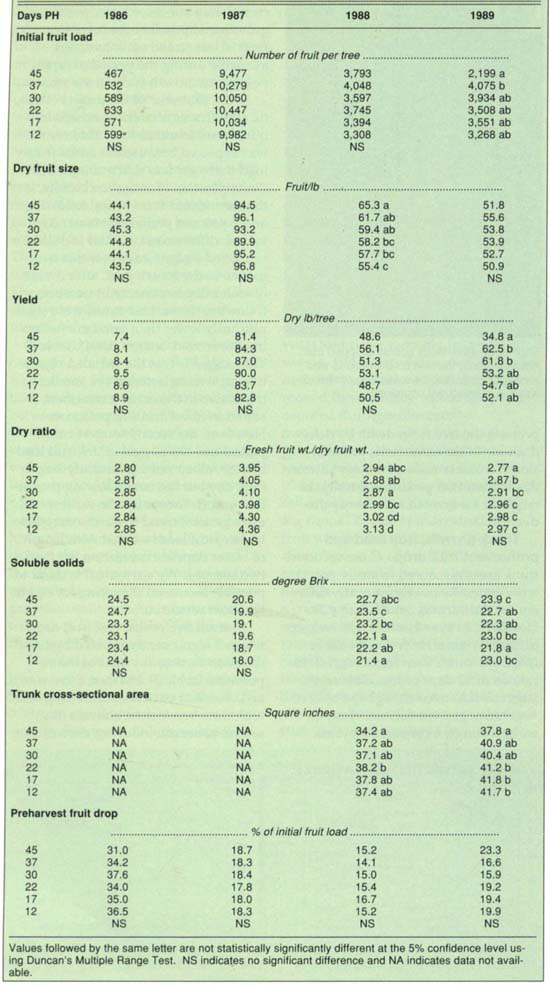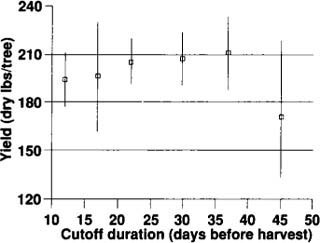All Issues
Early irrigation cutoff has little effect on French prune production
Publication Information
California Agriculture 48(4):13-17.
Published July 01, 1994
PDF | Citation | Permissions
Abstract
In a 4-year study conducted on a deep, well-drained soil, irrigation cutoffs ranging from 12 to 45 days before harvest had only minor effects on prune production. Soluble solids tended to be higher and dry ratios lower with early cutoffs. There were no differences in fruit drop. It appears that prune trees are relatively tolerant of moderate to severe water stress for several weeks before harvest.
Full text
Agricultural water use is being squeezed by increased competition from municipal and environmental interests as well as by periodic droughts. Faced with restricted and/or costly water supplies, tree fruit growers must decide whether they need to irrigate their orchards fully or whether deficit irrigation is an option. Orchard water use (ETc) is highest during July and August; therefore potential water savings are greatest during this period. For French prunes in the southern San Joaquin Valley, most of this 2-month period falls just before the mid-August harvest. During this time, important fruit maturation processes take place, including growth and accumulation of soluble solids. Optimal maturity for French prunes is defined as the point at which the flesh has softened to where it requires 3 to 4 pounds of pressure from a calibrated gauge to penetrate it. At that point, fruit sugar content is at its maximum, so that when the fruit are dried they will have the lowest fresh-to-dry weight ratio. A low fresh-to-dry ratio maximizes fruit size, yield and income.
A significant number of immature fruit often fall from the trees before harvest, resulting in a physical loss in yield. Harvesting before optimal maturity to avoid this fruit loss is not advisable, because the total crop will not have reached maximum fruit sugar content. Such a strategy results in poorer marketable yields and smaller fruit size because a high fresh-to-dry fruit ratio occurs. The increased yield due to minimal fruit loss does not compensate for the reduced yield resulting from high fresh-to-dry ratio and poor quality resulting from smaller fruit size.
How the length of time between the last irrigation and harvest affects premature fruit drop and fruit maturation, and thus yield and quality, is unknown. Large water deficits have been shown to reduce fruit size and quality in other stone fruits, especially when they occur during stages of rapid fruit growth. On the other hand, growers may have to consider deficit irrigating at some point during the season if water supplies are limited and /or costly. This paper reports the results of a 4-year study testing prune tree and crop response to various durations of water deprivation during the preharvest period.
Visalia trials
Our work began in 1986 in a 7-year-old commercial French prune orchard grafted on Myrobalan 29C plum root-stock spaced 21 by 18 feet apart (115 trees per acre), located in Visalia, Tulare County, California. The soil was a Foster Fine Sandy Loam, a deep and well-drained alluvial soil considered excellent for prune culture. Although the soil was quite sandy near the surface, its silt and clay fractions and thus its water-holding capacities increased significantly below 5 feet (table 1).
Dave Goldhamer uses a steady-state porometer to measure leaf stomatal conductance, an indicator of CO2 assimilation.
The orchard was irrigated with a low-volume system with two 5-gal/hr “foggers” per tree. During the first 3 years of the study, the system was operated on weekends to take advantage of lower power rates for off-peak use. The grower/cooperator handled irrigation scheduling during that period. In the last year of the study, the irrigation time was lengthened, at our request, to apply additional water. The purpose was to ensure that the trees were fully irrigated. In-line meters were used to monitor applied water after the first study year.
The experiment was designed as a randomized complete block with four replications (plots) of six irrigation regimes (treatments). Each plot consisted of 20 trees, in rows of 4 by 5. The interior 6 trees in each plot were monitored for tree and crop response. The perimeter trees served as borders and were managed the same as the monitored trees.
The irrigation regimes were based on having the latest cutoff 12 days before harvest (the normal grower practice), with intervals of about a week between regimes (table 2). This resulted in the earliest cutoff in the first week of July (45 days before harvest), with 8 to 9 acre-inches/acre less water being applied than in the latest cutoff regime. Because of uncertainty in projecting harvest dates, cutoff durations for each treatment varied slightly (6 days at the most) over the course of the study. Water was cut off by simply crimping the spaghetti tubes to the appropriate emitters. After harvest, all trees were fully irrigated for the remainder of the season.
We made diurnal measurements of tree water status and stomatal behavior every 90 minutes from 5:30 a.m. to 5:30 p.m. one day within a week of harvest during the first three study years. We assessed tree water status by measuring leaf water potential with a pressure chamber, sampling one leaf per tree on each of three trees in three replications per treatment. A steady-state porometer was used on the same trees to measure stomatal conductance on three sunlit leaves per tree. In year 4, tree water status was evaluated with twice-monthly predawn measurements of leaf water potential.
TABLE 2. Preharvest applied water, total rainfall, and estimated preharvest orchard water use (ETc) for the Tulare prune irrigation cutoff regimes*
Trunk circumference was measured at the end of the last two seasons on each monitored tree. In 1989, soil moisture content was assessed using a neutron probe with two access tubes installed in single plots of an early, middle and late cutoff.
Preharvest fruit drop was monitored weekly from the onset of the earliest irrigation cutoff during the first 3 years and twice monthly in the fourth season. We counted dropped fruit under each monitored tree and then removed them so they would not be recounted during subsequent measurements.
At harvest, the monitored trees were mechanically shaken and fresh yield determined using a portable load cell attached to the harvester's catching frame. To assess individual dry fruit weight and size, we collected about 3 pounds of fresh fruit from each tree's total harvest. These samples were weighed fresh, dried in a commercial prune dehydrator, reweighed and the fruits counted. Dry ratio (fresh-to-dry fruit weight), dry yield per tree, total number of fruit per tree (fruit load) and the number of dried fruit per pound (fruit size) were determined from these samples. Initial fruit load was calculated by adding cumulative fruit drop to fruit load at harvest. An additional 15 fresh fruits per tree were taken at harvest to determine soluble solids and flesh pressures. All data were analyzed by ANOVA using Duncan's Multiple Range Test.
Water cutoff's effect on trees
According to water meter measurements, in 1987 and 1988 cumulative applied water at each irrigation cutoff date plus effective rainfall (assumed for this study to be about 50% of total rainfall) was somewhat less than the estimated orchard water use (evapotranspiration, ETc), which we had calculated with published crop coefficients (Kc's) for deciduous trees and reference water use (ETo) obtained from a nearby CIMIS weather station (table 2). As a result, the trees suffered greater post-cutoff “stress” across all treatments than if they had been fully irrigated before the cutoffs. Recognizing that our results for years 1 through 3 may have been influenced by these unintentional pre-cutoff water deficits, additional water was applied in study year 4 (1989).
It must be emphasized that the precutoff water deficits during years 1 through 3 of the study may have had carry-over effects, most likely on flowering and fruit set, which would be manifested as fruit load. On the other hand, many of the factors other than initial fruit load that influence yield (such as fruit growth, sugar accumulation and dry ratio) are primarily affected by tree water status in the current season. Applying full irrigation in study year 4 allowed us to compare the effects of different cutoffs on yield components other than fruit load, and to contrast these with results in years 1 through 3.
Tree and soil water status. Early irrigation cutoff reduced soil moisture levels throughout the monitored depth of 8.5 feet. Just before the 1989 harvest, we found large differences in soil water content throughout the profile between the earliest and latest cutoffs (fig. 1), suggesting an expansive root zone that extracted deep soil moisture. For clarity, fig. 1 does not include soil water content for the 30-day cutoff regime, which was slightly greater than for the 45-day cutoff (July 7).
There were large differences in diurnal leaf water potential and stomatal conductance throughout the study. Representative data for August 12, 1988, are presented in figs. 2 and 3. Predawn (5:30 a.m.) leaf water potentials for the earliest (July 7) and latest (August 10) cutoffs were about -16 and -9 bars, respectively (fig. 2). Values decreased until 10 a.m. and remained relatively constant at about -31 and -23 bars for the early and late cutoffs, respectively, through 5:30 p.m. (1730 hours). Lower leaf water potentials indicate greater water stress, and are usually associated with less cell turgor. This effect can reduce both vegetative and fruit growth. In 1989, fully irrigated trees had predawn leaf water potential of about -4 bars at this time of the season, again contrasting with the effects of pre-cutoff deficit irrigation in years 1 through 3.
The time-course development of stomatal conductance on August 12, 1988, between the most and least severe cutoff regimes paralleled that of leaf water potential (fig. 3). Although both treatments showed highest conductance at 10 a.m. followed by declines through 4 p.m.(1600 hours), the values for July 7 cutoff were generally less than 50% of the August 10 cutoff values. Lower stomatal conductance reduces tree water loss and thereby protects the tree from death by dehydration. At the same time, partially closed stomata reduce photosynthesis, the process that produces the sugars required for growth and energy production.
Fig. 1. Soil water content profiles measured just prior to the last irrigation cutoff (August 9, 1989) for the earliest and latest cutoffs.
Technician Mike Butts counts dropped fruit. After counting, the fruit on the ground was swept away so that it wouldn't be recorded again in subsequent countings.
Trunk growth, fruit load and preharvest fruit drop. Cross-sectional trunk areas measured in study year 3 were generally not significantly different for the various cutoffs (table 3). However, in year 4, trunk size was significantly smaller in the earliest (45-day) cutoff than for the cutoff durations of 22 days or less. This result suggests that even though the bulk of vegetative growth occurs before the earliest cutoff, 4 consecutive years with an early-July cutoff can reduce tree size. The presumed causes are the cumulative effects of lower post-June growth and possibly the carry-over effects of less stored carbohydrates available during the period of rapid vegetative growth early in the season.
Fig. 2. Diurnal leaf water potential on August 12, 1988, for the earliest and latest cutoff regimes.
In the first year of the project (1986), no significant differences existed in initial fruit load (table 3). This result was expected because the initial fruit load that year was determined before the imposition of irrigation cutoffs. In the second and third years, following 1 and 2 years of preharvest water deprivation, differences in initial fruit load remained insignificant between treatments. In the fourth year, after 3 years of water deprivation, fruit numbers following the earliest cutoff were significantly lower than numbers following the second earliest cutoff (table 3). This suggests that the reduced vegetative growth reflected in the smaller trunk size in the earliest treatment resulted in fewer fruiting positions. However, the second longest cutoff period had the largest initial fruit load in 1989, albeit not significantly larger than any but the one following the earliest cutoff. Except for the earliest cutoff, a general trend toward somewhat higher fruit loads existed with length of water deprivation during the final two seasons. We attribute this trend to possible increased flowering for all but the most severe cutoff.
Cumulative preharvest fruit drop was not significantly affected by cutoff duration during any year of the experiment (table 3). Further, there was no consistent pattern in fruit drop rate with time between treatments from season to season (data not shown). For example, the highest percentage drop in 1987 occurred about 1 week before harvest, while in 1988 the highest percentage drop occurred about 4 weeks before harvest. Fruit drop in the other experimental years was evenly spread throughout the period monitored. There was no correlation in the timing and cumulative amount of fruit drop either with irrigation cutoff or with fruit load.
Fig. 3. Diurnal stomatal conductance on August 12, 1988, for the earliest and latest cutoff regimes.
TABLE 3. Effect of preharvest irrigation cutoff duration (PH) on yield, components of yield and trunk growth
Yield and fruit quality. Yield (dry pounds per tree) was not significantly influenced by the cutoff duration during the first 3 study years. In year 4, dry yield was significantly reduced only in the longest cutoff treatment, primarily reflecting lower initial fruit load, presumably due to reduced vegetative growth (table 3). Cumulative fruit yields for the 4-year project showed no statistically significant difference between treatments, although a slight increase with cutoff duration from 12 to 37 days suggests somewhat enhanced fruiting (fig. 4). On the other hand, cumulative yield was lowest with a 45-day cutoff, suggesting that a reduced canopy size more than offset enhanced fruiting.
Dry fruit size was significantly lower only once during the study — with the longest versus the shortest cutoff in the third year (table 3). Notably, applied water expressed as a percentage of estimated ETc (table 2) was least in the treatment with longest cutoff duration, suggesting that fruit growth may have been reduced.
Higher soluble solids generally correlated with cutoff duration (table 3). However, not until the third and fourth study years were statistically significant differences detected between treatments. The pattern of significance was not consistently related to cutoff duration during those years. Soluble solids influence the fresh-to-dry fruit weight ratio (table 3). Higher soluble solids with early cutoffs tended to be reflected in lower dry ratios.
Fig. 4. Cumulative dry fruit yield (4 years) in relation to irrigation cutoff duration. Vertical lines represent plus and minus one standard deviation for each treatment.
Summary
Both leaf water potential and stomatal conductance were reduced in relation to the duration of water deprivation before harvest. After 4 years, irrigation cutoff regimes ranging from 45 to 12 days prior to harvest had no significant effect on the cumulative amount or timing of preharvest fruit drop. Only in the fourth year were fruit load and dry yield reduced, and then only for the longest cutoff regime (45 days). This result was attributed to reduced vegetative growth limiting the number of fruiting positions. The next most severe cutoff regime (37 days) produced generally higher fruit loads, presumably due to increased flowering. Dried fruit size was not consistently affected by the cutoff duration. Soluble solids tended to be higher and dry ratios lower with early cutoffs.
Based on this study, we conclude that prune trees growing in deep, well-drained soils can tolerate moderate to severe water stress (equivalent to a maximum of about 7 acre-inches/ acre less ETc) for several weeks prior to harvest without major yield or quality losses. In shallow soils with smaller soil moisture reservoirs, more rapid development and magnitudes of tree water stress are likely, shortening the safe duration of preharvest water deprivation.



